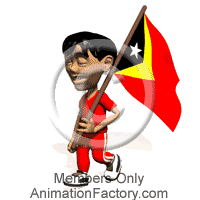The island of Timor has a long, proud history and a rich culture built over centuries. It has been referred to by some as the "cultural funnel of the East", for the many different ethnic influences which have contributed to the island's development.
Little is known of Timor before AD 1500, although Chinese and Javanese traders visited the island from at least the 13th century, and possibly as early as the 7th century, drawn by the abundance of aromatic sandalwood, honey and beeswax. Portuguese traders arrived between 1509 and 1511, but it wasn't until 1556 that a handful of missionaries established the first Portuguese settlement at Lifau - in the present-day Oecussi enclave.
During the 16th century, several Christianised regal lords placed themselves under the Portuguese Protectorate, which was then consolidated in the early 18th century with the arrival of its first governor. Their influence persisted and resulted in the colonisation of the island for over 400 years.
During World War II, the Allies (Australian and Dutch) engaged in heavy fighting with the Japanese forces in Timor. Their success was largely due to the support received from locals, for whom the cost was phenomenal. Several thousand East Timorese lost their lives fighting alongside the Allies. Portuguese rule was restored in Timor-Leste in 1945.
Following a coup in 25 April 1974, Portugal set about discarding its colonial empire. Within a few weeks, political parties had been formed in East Timor, and the Timorese Democratic Union attempted to seize power in August 1975. A brief civil war saw its rival Fretilin come out on top, declaring the independent existence of the Democratic Republic of East Timor on 28 November.
But Indonesia opposed the formation of an independent East Timor, and on 7 December launched its attack on Dili. By 1976 there were 35,000 Indonesian troops in East Timor. The cost of the brutal takeover to the East Timorese was huge; it's estimated that at least 100, 000 died in the hostilities, and ensuing disease and famine.
By 1989, Indonesia had things firmly under control and opened East Timor to tourism. Then, on 12 November 1991 Indonesian troops fired on protesters gathered at the Santa Cruz Cemetery in Dili to commemorate the killing of an independence activist. With the event captured on film and aired around the world, the embarrassed Indonesian government admitted to 19 killings, although it's estimated that over 200 died in the massacre.
While Indonesia introduced a civilian administration, the military remained in control. Aided by secret police and civilian Timorese militia to crush dissent, reports of arrest, torture and murder were numerous.
Timorese hopes for independence remained high, but Indonesia showed no signs of making concessions until the fall of the Soeharto regime. Shortly after taking office in May 1998, Soeharto's successor, President Habibie, unexpectedly announced a referendum for East Timorese autonomy. On 30 August 1999, East Timor voted overwhelmingly (78.5%) for independence from, rather than autonomy within, Indonesia. Though the Indonesian government promised to respect the results of the UN-sponsored vote, military-backed Timorese militias massacred, burnt and looted the country.
International condemnation led to UN troops bringing peace to East Timor beginning in September 1999. Half a million people had been displaced, and telecommunications, power installations, bridges, government buildings, shops and houses were destroyed. Today these scars are everywhere.
The UN set up a temporary administration during the transition to independence, and aid and foreign workers flooded into the country. As well as physically rebuilding the country, East Timor has had to create a civil service, police, judiciary, education, health system and so on, with staff recruited and trained from scratch.
The UN handed over government to East Timor on 20 May 2002. Fretilin military leader Xanana Gusmão was president of the new nation, and Fretilin leader Mari Alkatiri was prime minister.
In December 2002, Dili was wracked by riots as years of poverty and frustration proved too much. The economy was in a shambles and people were ready for things to start improving - and fast. But without any viable industry or employment potential, East Timor was reliant almost entirely on foreign aid.
Only a small UN contingent remained in East Timor by mid-2005. As the number of outsiders shrank, the challenges of creating a new nation virtually from scratch became all too apparent. Government factions squabbled while the enormous needs of the people festered. By 2006 it was clear that too much had been expected too soon.
Gas and oil deposits in the Timor Sea have the greatest potential to help East Timor's economy to develop without the assistance of foreign aid. High in the hills above Dili is another resource: coffee. Some 50, 000 people work to produce the country's sought-after Arabica beans, noted for their cocoa and vanilla character. Shade-grown and mostly organic (because few farmers can afford fertilisers and pesticides), Timorese coffee is prized by companies such as Starbucks, and production is increasing.
For further information http://en.wikipedia.org/wiki/East_Timor






No comments:
Post a Comment